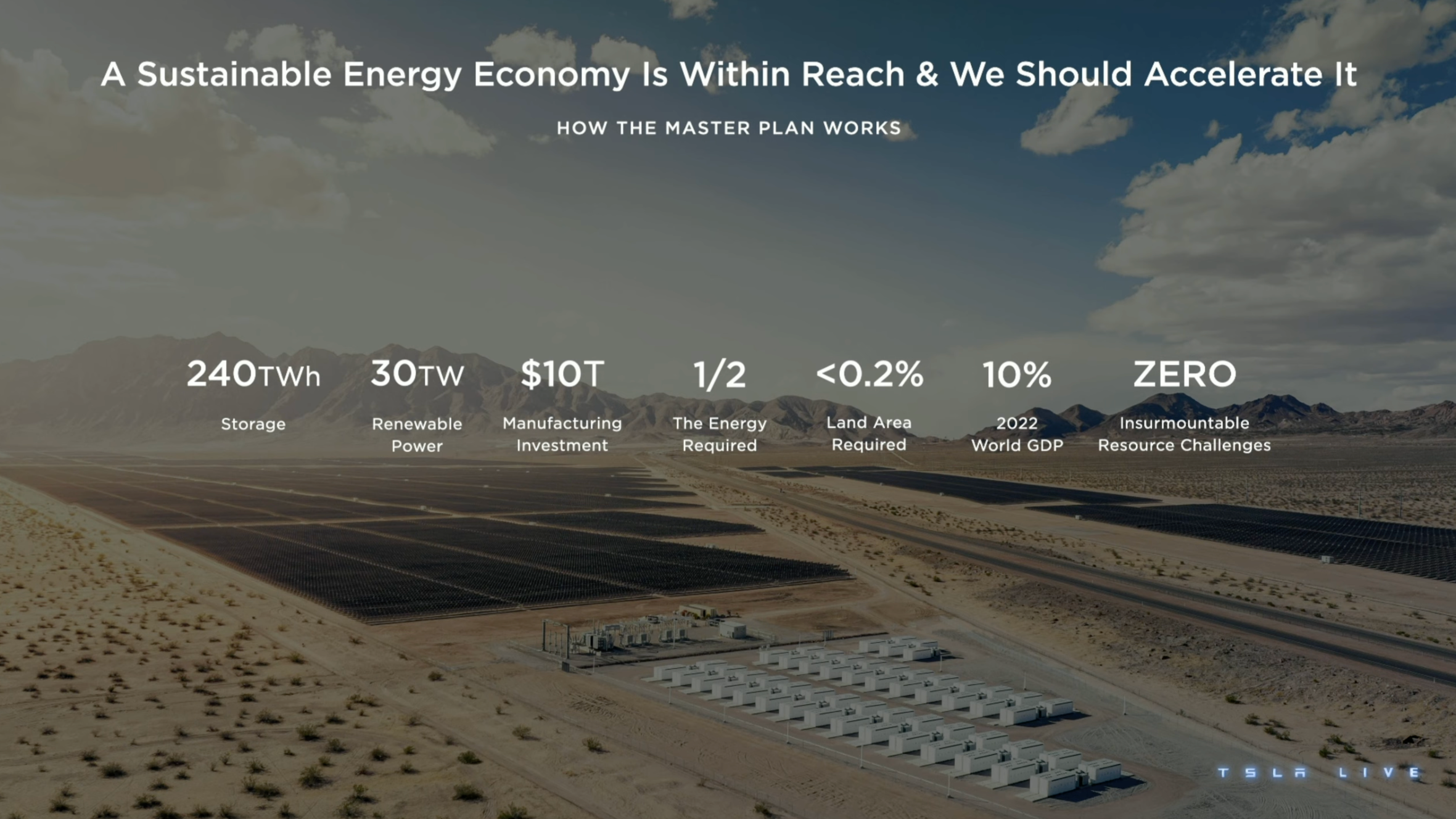The land area of the Philippines is 299,700 square kilometers, which accounts for 0.2% of the total land area of the Earth.
According to calculations by Tesla, if all of this land area was used for renewable energy construction, with an investment of $100 trillion USD to install 3 billion kilowatts of wind and solar power generation equipment along with 24 billion kilowatt-hours of battery energy storage for peak power shaving and load shifting, the energy generated would be sufficient to support the operation of the entire world, thus making our planet achieve “self-sustaining” energy.
“Accelerating the transition to sustainable energy in the world” has been Tesla’s unchanged vision for a long time, and it is also the biggest theme of Tesla’s 2023 Investor Day.
Tesla wants to save the Earth, but the problem facing consumers is very direct – Will you buy Tesla’s products because of this?
For me, the answer is NO.
What do Tesla and Pinduoduo have in common?
Answer: They are both very good at “discounting”.
Tesla’s gross profit margin per car for the full year 2022 is 28.5\%, while the Ideal and NIO companies in China have gross profit margins of 19.1\% and 10.4\%, respectively. Another set of more contrasting data is that Porsche’s car gross profit margin for H1 2022 is 26.4\%.
The conclusion is obvious: Tesla makes a lot of money selling cars.
Looking at another set of data: Porsche’s average car price is $116,900 USD, while Tesla’s is $54,400 USD. The supplementary conclusion is that Tesla knows how to make money.
Tesla’s profit-making skill can be summed up in one word – cost reduction.
There were many topics related to “cost reduction” at this Tesla Investor Day, but the only conclusion that consumers need to pay attention to is that Tesla’s cost reduction goal for the next generation vehicle platform is 50\%.
The “cost” here refers to the full-chain cost, including but not limited to:
- Vehicle basic cost;
- Battery + electric drive system cost;
- Production and manufacturing costs.
One point worth mentioning but usually not included in Tesla’s PPT is that their goal is not achieved overnight, it will take several years to gradually implement just like a factory needs to experience a capacity ramp-up period during the initial production stage.Why do I mention this to you?
Because in the past few years of writing about Tesla, I have noticed a pattern: the company is keen on doing things differently and pushing the limits, both in terms of execution and in their presentations.
Therefore, I suggest that you approach the following content with the mindset that “Tesla is probably capable of achieving their plans, but the degree and timing of their success may not meet our expectations.”
The “doing things differently” aspect is perhaps the most fascinating part of Tesla’s presentations, where the company continues to challenge themselves, their competitors, and even the laws of physics in various areas and metrics.
In this process, Tesla has rethought many things that people take for granted, such as the traditional way of building cars, which they believe is fundamentally flawed.
Cars should be assembled like Lego bricks, not manufactured like traditional cars
A car has tens of thousands of components and the manufacturing and assembly processes are complex and tedious.
The most labor-intensive part of the process is the final assembly, where workers on the assembly line need to install various parts on the car body, including wiring, interior parts, seats, doors, powertrain, and various chassis components.
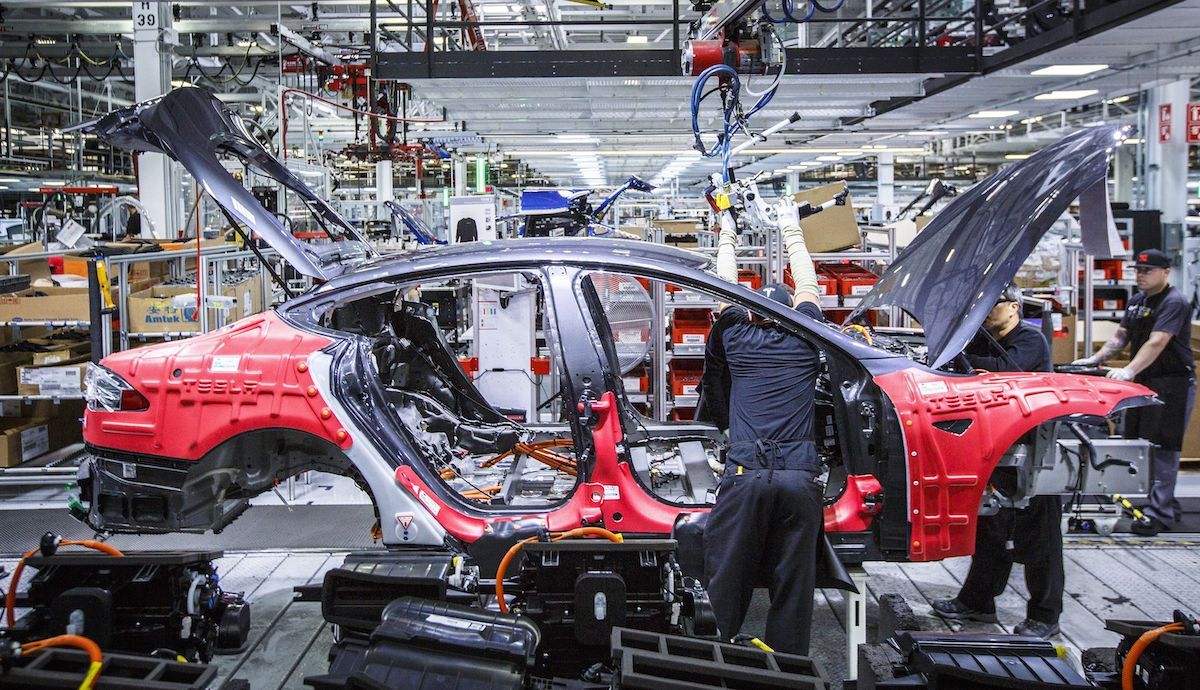
Workers on the assembly line need to constantly enter and exit the car to install and adjust parts. At this point, the welded white body is like a large cage, limiting the range of movement and freedom of industrial robots and workers.
Tesla’s three main dimensions for improving manufacturing efficiency are:
- Integration of the car body structure to reduce the total number of parts;
- Decentralization of assembly to increase the “worker/parts” ratio;
- Elimination of secondary assembly, with all components assembled in advance and the vehicle assembled in one step.
The following demo video shows the final result:
In essence, Tesla hopes to further break away from the assembly line approach to car manufacturing, and maximize parallel manufacturing and assembly in future models.
This idea was inspired by Lego bricks. Nobody assembles Lego bricks inside a completed Lego model, but everyone assembles a car inside the car body.In the execution end, parallelism means efficiency, just as parallelism in thinking.
Only car manufacturers that can’t do anything else are not good car manufacturers
After the shareholders’ meeting, Tesla’s stock price dropped a lot, and investors generally felt that this conference was not as expected.
Apart from the new cars of the “third-generation platform” not being unveiled, many foreign analysts’ common feeling is that Tesla has stated its goals, but the details of how to achieve these goals are not specific enough, and many concepts are too vague.
Regarding this type of opinion, I think we should divide it into chapters. I did have this feeling about the part of the conference that talked about energy and sustainable development, but the part of returning to Tesla’s main business is not like this, such as Tesla’s explanation of how its car manufacturing business has evolved.
During the first-generation Model S period, Tesla’s car production process was not unfamiliar to everyone: first design the vehicle, then consider engineering implementation, and finally implement production and manufacturing.
Different teams at different stages of the linear process were rigorous and clearly in charge of their own responsibilities, which is a true portrayal of the linear organization in the industrial age.
However, in the manufacturing industry, there is often such a situation: the optimal solution in the designer’s mind is sometimes a nightmare for the engineering and manufacturing teams.
Soon everyone realized that when pursuing larger scale, a good product not only needs excellent performance, but also good manufacturability and cost control.
So, starting with Model 3, Tesla’s new car engineering and manufacturing plans worked in parallel with vehicle design. The team’s thinking about car manufacturing increased from one dimension to three dimensions, and Model 3 born under this new thinking became an electric car with low cost, high performance, and long range.
But as we all know, Model 3 also experienced a production hell that almost bankrupted Tesla. Because “automation feasibility” was not fully considered in the design stage, Musk overconfidently expected complete automated production of Model 3, including final assembly, but at that time, neither the vehicle design, production line, nor manufacturing equipment could meet the required level of automation.
Why is automation so tempting that Musk takes risks?
Tesla made a straightforward comparison. By introducing the automated production line designed by Tesla, the number of production processes of Tesla’s heat pump supplier was reduced from over 1,000 to 10, and the demand for labor was reduced by 99%.
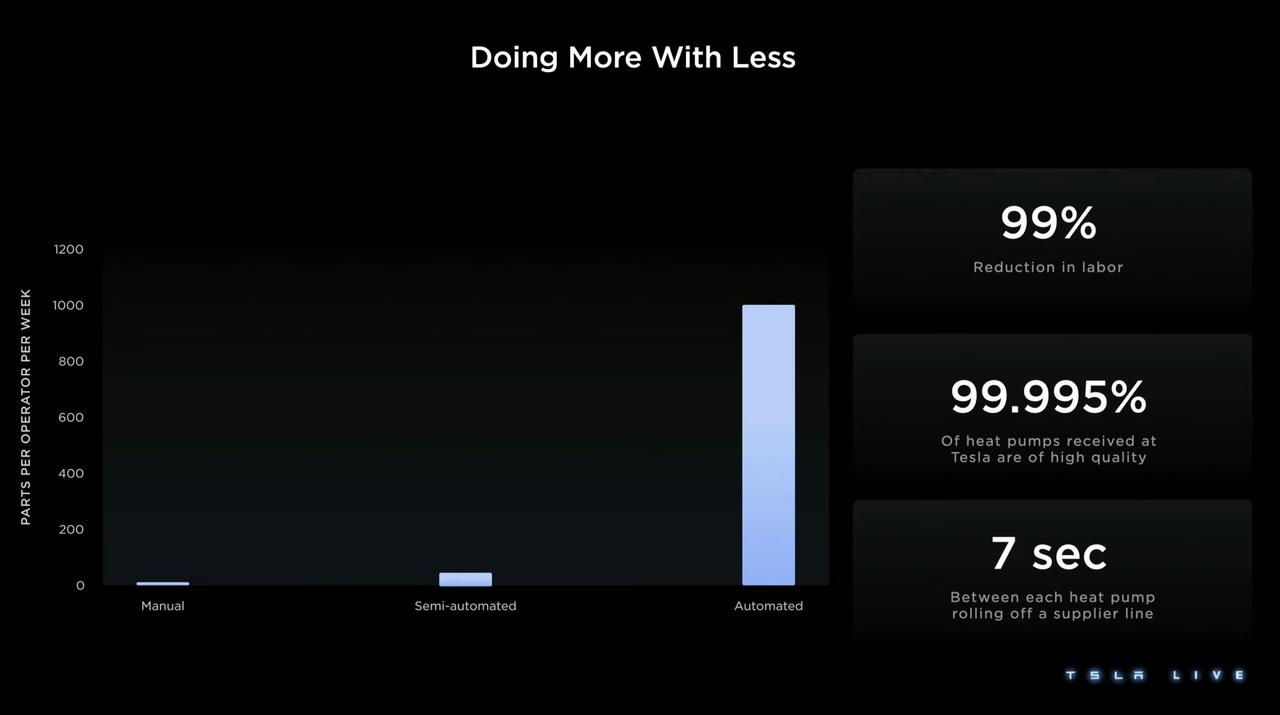 Nowadays, “Automation Feasibility” has become the fourth major factor in Tesla’s “parallel car-making process” after design, engineering, and manufacturing. The integrated die-cast body is a typical case under this thinking.
Nowadays, “Automation Feasibility” has become the fourth major factor in Tesla’s “parallel car-making process” after design, engineering, and manufacturing. The integrated die-cast body is a typical case under this thinking.

Tesla’s multi-dimensional and full-chain parallel thinking and decision-making in car-making is essentially seeking to reduce internal friction on the road to the optimal solution. For a company of Tesla’s size, this is a deep-rooted cost-reduction strategy.
Tesla’s cost-reduction culture
When it comes to cost reduction, reducing configurations is the easiest and most common way, but also the most resistant way for consumers.
If your boss tells you one day that the cost of the new product needs to be reduced, but the product performance cannot be reduced, and even the performance improvement needs to be realized while reducing costs, he is probably PUA you. Where in the world can such good things happen?
But if every department of a company thinks like this, and knows how to act in unison, then it has the possibility to achieve it.
You guessed it, I’m talking about Tesla.
This crazy company even tried to combine this thinking with “reducing configurations” in an attempt to achieve cost reduction without reducing product performance.
The power module circuit board on the left side of the picture below has four microcontroller chips, which use a lot of SiC devices to improve circuit efficiency. The circuit board on the right side has only one microcontroller chip, and the amount of SiC is also less, which belongs to the typical reduce-configuration strategy in terms of materials, and the actual cost of this board only requires half of the cost of the left circuit board.
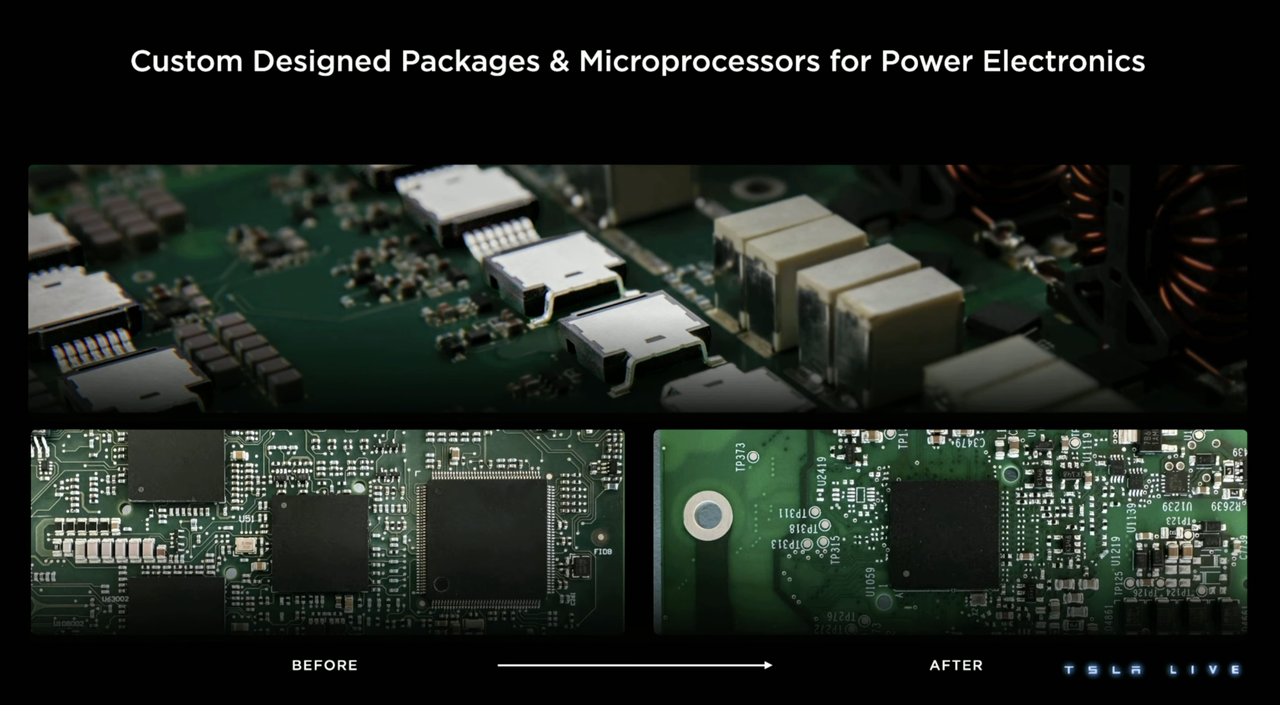
The circuit board on the right is the charging component of the 2012 Model S. Tesla achieved the effect of one reducing to four by designing a dedicated microcontroller chip by itself. Meanwhile, the new custom-designed circuit board of Tesla can reduce the amount of SiC because of its doubled heat-resistant ability so that the typical Tesla-style reducing configuration was completed.
Cost reduction is still continuing on Tesla’s new platform vehicles:
- SiC device usage reduced by 75%;
- No rare earth elements used in permanent magnet motors;
- The total cost of the electric drive assembly is reduced to about 1,000 US dollars.
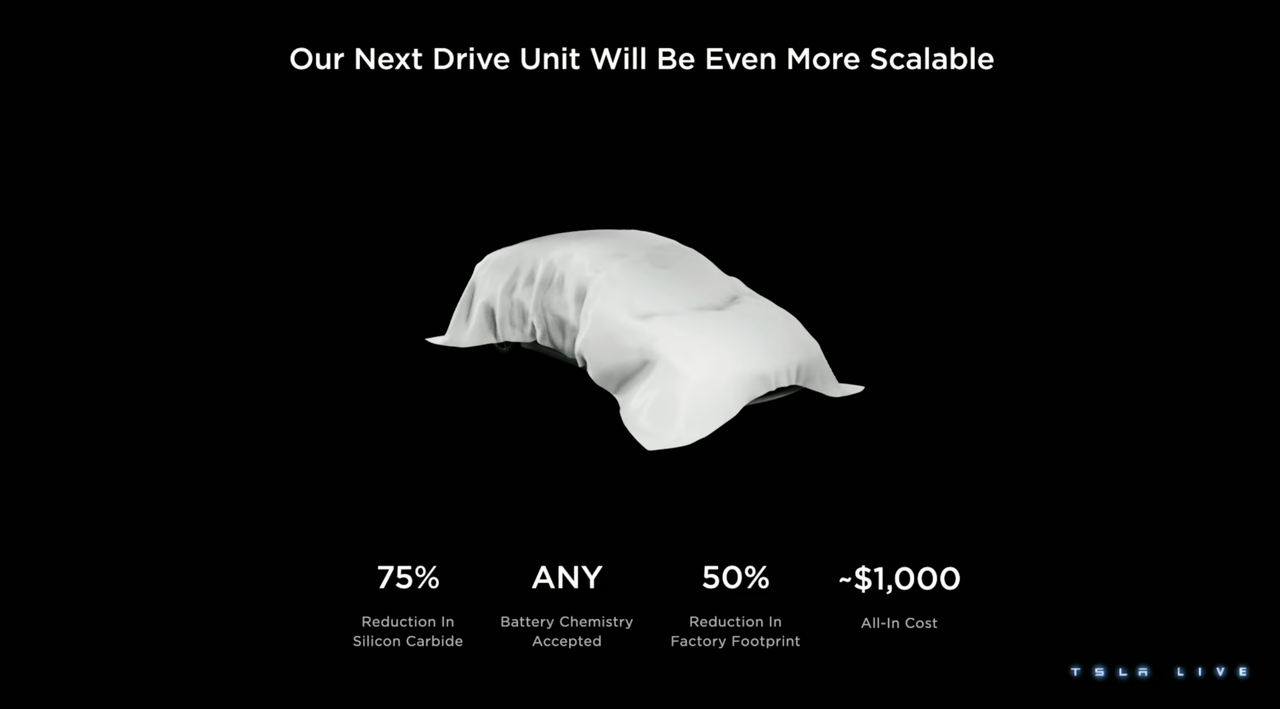
“Cost reduction through streamlining features” can be seen as a reflection of Tesla’s execution capability, but Tesla’s cost reduction scope goes far beyond simply reducing features. Tesla believes that there are seven key factors for cost reduction:
- Economies of scale
- Increasing productivity
- Efficient expenditure
- Product optimization
- Engineering improvements
- Localization improvements
- Expanding the supply chain scale

These seven points are easy to understand. The actual effects of Tesla’s “cost reduction through streamlining features” are applied to these seven major areas. The results can already be clearly felt in the selling price and gross margin of each Tesla model.
Tesla’s purpose in sparing no effort in cost reduction is clear – to lower the cost of their vehicles so that more people can afford them.
To some extent, the way Tesla attracts users is similar to Pinduoduo, but the difference is that Tesla’s “cutting” process is self-directed.
Tesla still wants to save the Earth, but the problem facing consumers has now changed to another – if it is cheap enough, would you buy Tesla’s products?
The hot sales after each price reduction by Tesla have already answered this question.
Considering how much this company has done to make electric cars affordable for you, are you interested in spending a little more time to learn about how this company plans to save the Earth?
The Prequel to The Wandering Earth: Energy Crisis
There are two major crises facing human existence on Earth – one is the population crisis, and the other is the energy crisis.
The first problem can be summarized as a shortage of Earth’s resources due to the continuously increasing global population. The second problem is that the fossil fuels that the human society mainly consumes constitute a limited deposit on this planet. In plain terms, human civilization has developed so far by “living off the land.”
For example, according to the consensus based on the already discovered reserves and the current consumption rate of fossil fuels like petroleum, it is estimated that there is only about 50 years of these resources left – a number that is enough to cause range anxiety in all combustion engine drivers around the world.The deposit of fossil energy is almost running out, but we still need to go on living and spending.
Someone may ask: Can’t we earn money ourselves instead of relying on our parents?
As a matter of fact, there is a big boss that has been accompanying human civilization for many years and giving us money every day, and it is the sun.
The energy radiated by the sun to the earth every day is approximately 1.5 x 10^22 joules, which is equivalent to 4.17 x 10^15 kWh. This is 25.3 times the total annual energy consumption of the world.
This means that collecting and utilizing a very small part of the energy transmitted by the sun to the earth is sufficient to support the normal operation of human society, and thus get rid of relying on fossil energy.
Strictly speaking, the sun also has a lifespan, but its lifespan is about 5 billion years. Therefore, it is not a big problem to call the solar energy and its variants collected in various ways “sustainable energy”.
Musk’s “tax evasion” tutorial on energy
The progress of our self-sufficiency in energy is not fast at present. Nowadays, renewable energy accounts for 20% of the total energy consumption in the world.
However, in Musk’s opinion, the remaining progress is not 80%, and there is a relationship similar to the one between pre-tax income and after-tax income.
The effective utilization rate of fossil energy is the “tax” among them, and many people are not aware that the tax rate is as high as 66.7%. The effective power obtained in the process of consuming fossil energy is only one third of its storage. Taking the most familiar example of our cars, if we take into account the extraction, processing, and transportation of crude oil, the full-chain energy utilization rate of gasoline-powered cars is less than 20%.
Therefore, reversing the calculation, in the fossil energy sector that accounts for 80% of the total energy consumption, the real energy demand of human beings, namely the “after-tax” energy, actually only requires one third of the “pre-tax” amount.
Compared with fossil energy, the “tax rate” of electricity is much lower. For the same “after-tax energy” demand, the “pre-tax” development amount of electric energy can be greatly reduced. Taking into account the losses in various links, if all energy consumption links in the world ultimately switch to renewable energy, the total energy required by human society will only be half of the current amount.
 Tesla came up with a grand plan to save the Earth by achieving 100% self-sufficiency in renewable energy, which is officially called “Master Plan 3”.
Tesla came up with a grand plan to save the Earth by achieving 100% self-sufficiency in renewable energy, which is officially called “Master Plan 3”.
From the perspective of the conclusion, the plan can be simply divided into two major parts:
- Build more renewable energy facilities;
- Replace more electric devices with heat engines.
Regarding this grand plan to save the Earth, Musk mentioned “only” many times during the press conference. The last time I had a similar feeling was when Wang Jianlin talked about his “small goal”.
How big are human “small goals”
The first number is 240 TWh, which is the total amount of energy storage stations and electric vehicles with power in Tesla’s calculations to achieve a completely sustainable energy society.
To give you a rough idea of this number, the global power battery shipments in 2022 are 685.3 GWh, and the energy storage battery shipments are 142.7 GWh.
The second number is 30 TWh, which is the total power of renewable energy generation needed in the plan. The global new photovoltaic and wind power generation in 2022 is 220 GW.
The third number is a total construction investment of 10 trillion US dollars. This is equivalent to 10\% of the global GDP in 2022, or according to Tesla’s single car price of 54,400 US dollars in 2022, it is equivalent to selling 184 million cars.
The fourth number is 0.2% of the global land area, which is the total area of renewable energy infrastructure in the plan, and it is as large as the entire country of the Philippines.
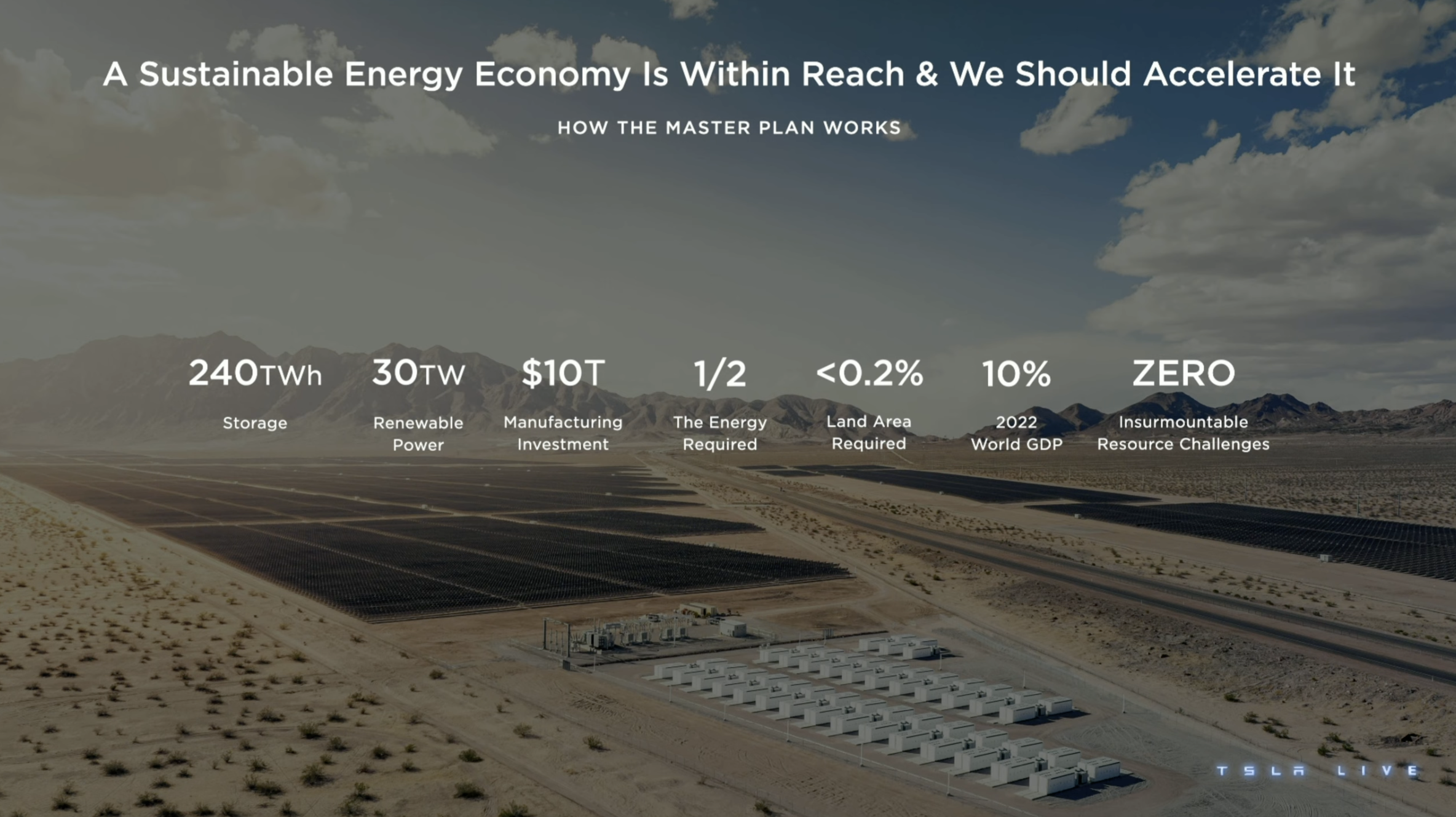
These numbers are quite amazing, but this “surprise” mainly comes from our role and perspective: we are consumers and investors, with a normal basic industrial knowledge, economic concept, and time perception as an ordinary person.
However, if we change our perspective and imagine ourselves as the Earth itself, you may understand that the thinking of “achievable” and “within reach” mentioned during the press conference was only based on Tesla’s first principle.
For example, regarding the most crucial issue of money, Musk believes that when the time is extended to 20 years, the investment of 10 trillion dollars will only account for 0.5\% of the global GDP, which is not exaggerating.For example, people often worry about whether our mineral resources are enough to support such large batteries. Tesla has provided a table directly showing that the minerals required for complete sustainable energy will not exceed the Earth’s existing reserves. The most commonly mined mineral, nickel, accounts for 30% and is not expected to lead to resource depletion. Moreover, with the rise of battery recycling industry, the demand for mining will gradually decrease.
Don’t underestimate battery recycling. The recycling utilization rate of the main metal materials in waste batteries by Redwood Materials, CTO JB Straubel’s start-up company that was associated with Tesla, has already exceeded 95%.
With this in mind, it doesn’t seem unreasonable to let Tesla explain further.
Five measures to move away from fossil fuels
Based on fossil fuel consumption, Tesla has identified five key areas to replace fossil fuels:
First, promote renewable energy generation to reduce fossil fuel dependence by 35%, requiring 10 TW of wind and solar energy, 24 TWh of energy storage, and a total investment of 800 billion US dollars;
Second, replace gasoline cars with electric cars to reduce fossil fuel dependence by 21%, requiring 4 TW of wind and solar energy, 115 TWh of batteries and energy storage, and a total investment of 7 trillion US dollars;
Third, switch home, commercial, and industrial heating to heat pumps (currently, heat pumps are only used in 10% of building heating), which can reduce fossil fuel dependence by 22%, requiring 5 TW of wind and solar energy, 6 TWh of energy storage, and a total investment of 300 billion US dollars;
Fourth, replace electric heating and clean hydrogen in the industrial high-temperature field to reduce fossil fuel dependence by 17%, requiring 6 TW of wind and solar energy, 48 TWh of energy storage, and a total investment of 1 trillion US dollars;
Fifth, enable ships and planes to achieve electric and clean fuel drive to reduce fossil fuel dependence by 5%, requiring 4 TW of wind and solar energy, 44 TWh of energy storage, and a total investment of 800 billion US dollars.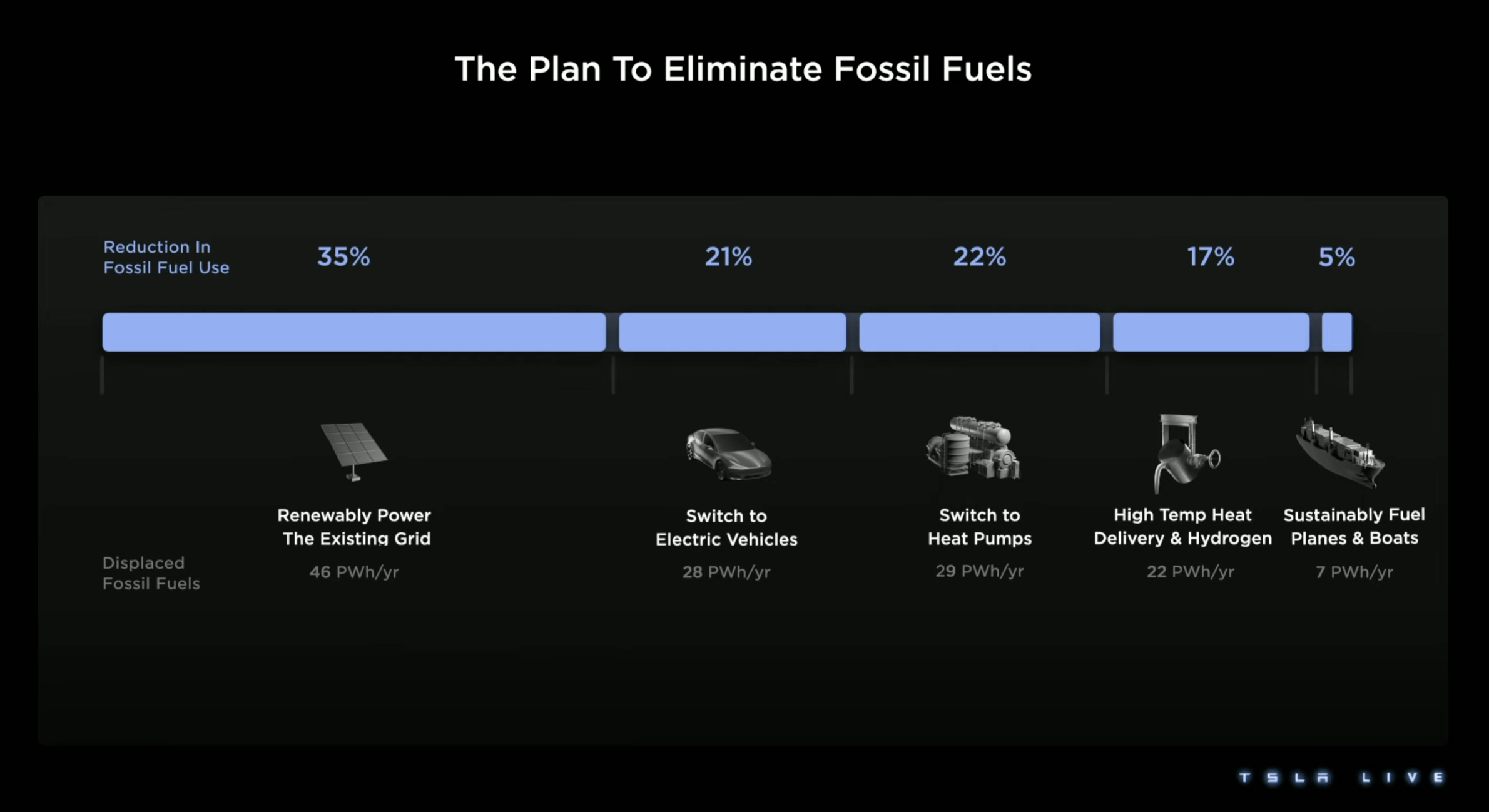
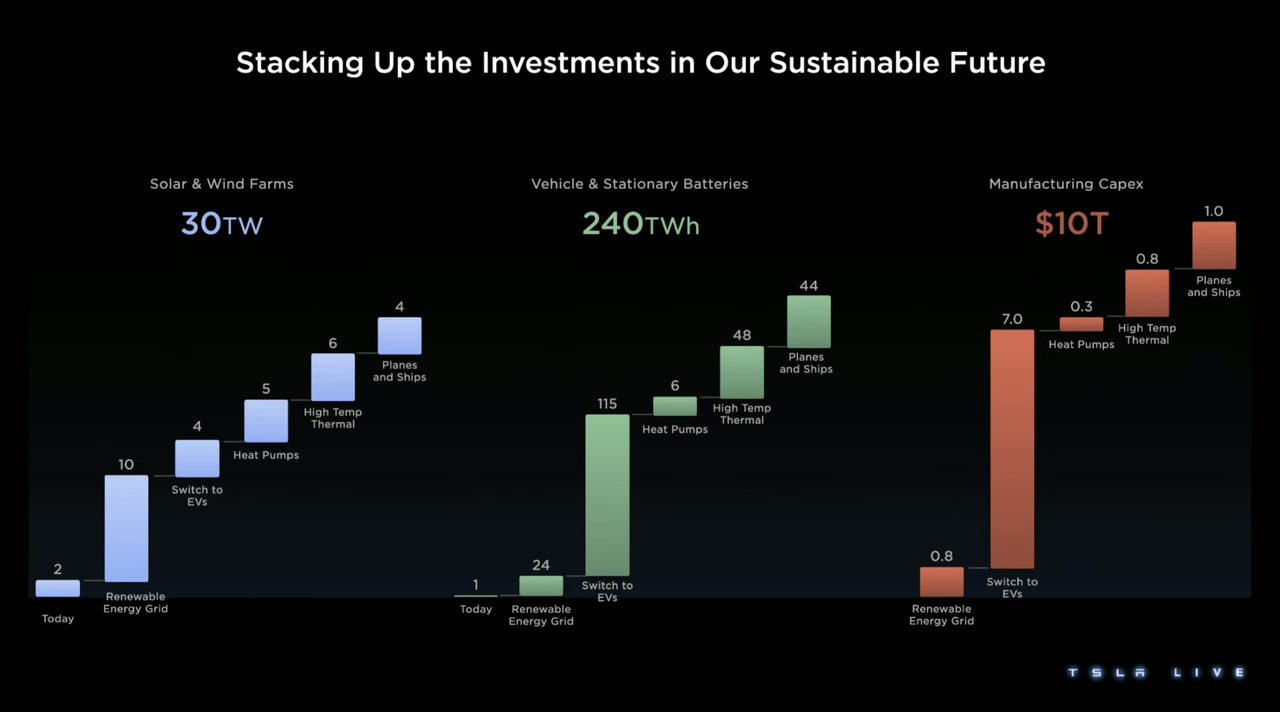
Regarding the last point, Musk believes that battery cells with an energy density of 450 Wh/kg can be used to power electric airplanes, and fossil fuels for certain vehicles that require fuel can be replaced with artificially produced methane and hydrogen.
The most concerning and curious question is, how much longer will it take to achieve all of this?
Tesla has taken the reverse approach, assuming that humans will achieve fully renewable energy by 2050. For the next 20 years, starting in 2030, we must accomplish the following each year:
- Build 1 TWh of wind and solar power facilities (an increase of three times compared to 2022);
- Build 16 TWh of energy storage facilities (an increase of 29 times compared to 2022);
- Sell 85 million new energy vehicles (an increase of 11 times compared to 2022).
During this process, Tesla hopes to contribute 20 million electric vehicles and 1 TWh of energy storage each year after 2030.

The above is Tesla’s vision for changing human destiny through an energy revolution.
Saving the Earth is a Vision, Not a Burden
However, technology and corporate vision are not related to investor interests. They care about Tesla’s performance and growth, and about Tesla’s new products. The rumored $25,000 car was not announced at the 2023 Investor Day.
As a result, Tesla’s stock plummeted more than eight points at the opening, and some analysts even wrote headlines such as: “Tesla’s Master Plan 3 Looks Like A Flop“.I understand the disappointment of investors, as I stated at the beginning: Tesla’s corporate vision is to “accelerate the world’s transition to sustainable energy”, but I wouldn’t buy a Tesla simply because of this.
However, I would buy it because of Tesla’s excellent product quality and highly competitive prices.
This is where Tesla excels: on the one hand, it has a grand vision of benefiting all mankind by breaking away from the traditional way of life, but at the same time its success in product and business model relies not on “moral kidnapping” but on its hard power that consumers are willing to buy under market competition.
Moreover, Tesla has actually revealed enough information about its new car in this event:
- The new car will achieve a fully integrated development of design, engineering, manufacturing, and automation;
- The body structure is more modular, with a front and rear aluminum casting body + chassis integrated battery pack;
- The new car will adopt a parallel assembly process to reduce manufacturing process by more than 40%;
- The electric drive system has 0 rare earth usage and low SiC usage, with a total cost of about 1,000 US dollars;
- The in-car controller is fully self-developed (61% for Model Y, 85% for Cybertruck) to achieve part-level control of the supply chain;
- It adopts a 48V low-voltage electrical platform, reducing current by 75% and heat consumption to 1/16 of the 12V architecture;
- The controller uses Ethernet communication instead of CAN communication.
After the press conference, Tesla fan Matthew Donegan-Ryan added several more revelations:
- The new car will be produced first in the Mexican factory, followed by other factories;
- The new car will be off the production line in 18 to 24 months;
- The new car may not have a coating, just like the Cybertruck.

So, I can imagine that the third-generation model is another typical Tesla, a popular electric vehicle that reduces the cost of the entire supply chain by using a variety of broad-based human technological means to achieve the most down-to-earth consumerism value of “cost performance ratio”.
Conclusion
Tesla’s 2023 Investor Conference is an unconventional press conference. Including the QA session, the total time of the conference is three and a half hours, but every minute is packed with information and has a high level of understanding. Every speaker who takes the stage is an outstanding business leader of Tesla, and this article may only contain 10% of the information.
This press conference made me think: What is the purpose of technology?
Tesla’s answer is “cost reduction”.
From batteries to cars, from consumers to industries, from technology to processes, cost reduction is the ultimate contribution of technology to humanity, and the most concentrated expression of all Tesla’s abilities.
Master Plan 3, which is full of astronomical figures, comes with a huge cost, but the higher the cost, the more worth it is to reduce it.
If you can’t understand Tesla and Musk’s optimistic attitude towards this plan, maybe you can see it this way: the $10 trillion investment in Master Plan 3 is actually less than 1/6 of the total value of China’s real estate.
This article is a translation by ChatGPT of a Chinese report from 42HOW. If you have any questions about it, please email bd@42how.com.
